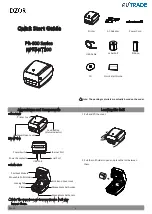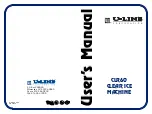
6.2 START-UP
When you start up the appliance the first time, or when you start it up again after a long period at a standstill, fill the basin
manually with water (Fig. 8).
This filling operation must be carried out by opening the door, raising the flaps (if any) and pouring the water directly into the internal basin.
In the cycles subsequent to the initial one, the appliance will be filled with water in a fully automatic way.
Once the appliance has been correctly connected to the electricity mains, water mains and water drain system, it can be started up as
follows:
a)
turn on the water supply tap (8 in Fig. 4)
b)
insert the plug (if any) in the socket and switch on the power supply by means of the relative switch fitted during the installation phase
(7 in Fig. 4)
Switch on appliance by pressing the luminous switch (16 in Fig. 3).
For appliances that are connected permanently to the electricity mains, turn on by means of the switch on the outside of the appliance,
fitted during the installation phase.
6.2.a STARTING UP MODELS WITH CONTINUOUS DELIVERY (Fig. 9)
Carry out operations a) and b) described above; then:
• remove the plug (17) on the front grille panel
• using a screwdriver turn the adjusting screw of the timer clockwise until you hear a click and the water pump stops
• repeat the previous operation three times consecutively at intervals of one minute each
• when this operation has terminated, fit the plug (17) back on the front grille; the appliance will automatically start producing ice
6.3 CLEANING THE STEEL PARTS
The appliance was cleaned initially in the factory. For subsequent cleaning operations on the steel parts of the machine, comply with the
instructions below:
Do not allow saline solutions to dry or pool on the external steel components of the machine, as this may lead to corrosion.
Avoid contact with ferrous material (scourers, forks, ladles, scrapers, etc.) to prevent corrosion, contamination from ferrous particles
circulating in the receptacle.
Carefully clean the stainless steel parts with a damp cloth, water and soap or common, non-abrasive chlorine or ammonia based
detergents.
7 MAIN CAUSES OF OPERATING FAILURE
Should the appliance fail to produce ice, before calling on the Authorized Technical Service Centre, first check carefully that:
• the water supply tap (8 in Fig. 4), fitted during the installation phase, has been turned on
• electric power is reaching the appliance; the plug (if any) is properly inserted in the socket, the switch (7 in Fig. 4) is in the “ON” position,
and the push button (16 in Fig. 3) is lighted up
Furthermore:
• if there is excessive noise, make sure that the appliance is not touching furniture or sheet metal which can give rise to noise or vibrations
• should any trace of water appear, check the drain hole of the container to ensure that it is not clogged, that the water fill and drain pipes
are correctly connected and are not throttled or damaged
• make sure that the temperature of the air or water does not exceed the installation limit values (see paragraph 5.2)
• make sure that the water inlet filter is not clogged (see paragraph 9.1)
• make sure that the spray nozzles are not clogged with scaly deposits
If the fault still persists after the above inspections have been made, turn off the electric power source by means of the switch fitted during
the installation phase, pull out the plug from its socket, turn off the tap connecting the appliance to the water mains, and contact the
nearest Authorized Technical Service Centre.
To obtain a faster and more efficient reply when you call the Centre, state the model of the appliance precisely, together with its serial
number or manufacturing number. This information is given on the serial N° plate (Fig. 1) affixed to the rear of the appliance and on the
cover of this manual.
8 OPERATION
The appliance has a thermostat probe in the ice bin, which stops ice production when the ice accumulated in the bin reaches the probe
connected to the thermostat.
When ice is taken from the bin, the thermostat will automatically reactivate ice production, thus creating a new supply of ice.
8.1 MODEL WITH CONTINUOUS DELIVERY (Fig. 10)
Summary of Contents for 104.805A
Page 79: ......
Page 80: ......
Page 81: ......
Page 82: ......
Page 83: ...15 16 ...
Page 84: ...17 18 ...
Page 85: ...19 20 21 ...
Page 86: ...22 23 ...
Page 87: ...24 ...
Page 88: ...25 ...
Page 89: ...26 15 27 28 ...
Page 90: ...29 30 ...
















































